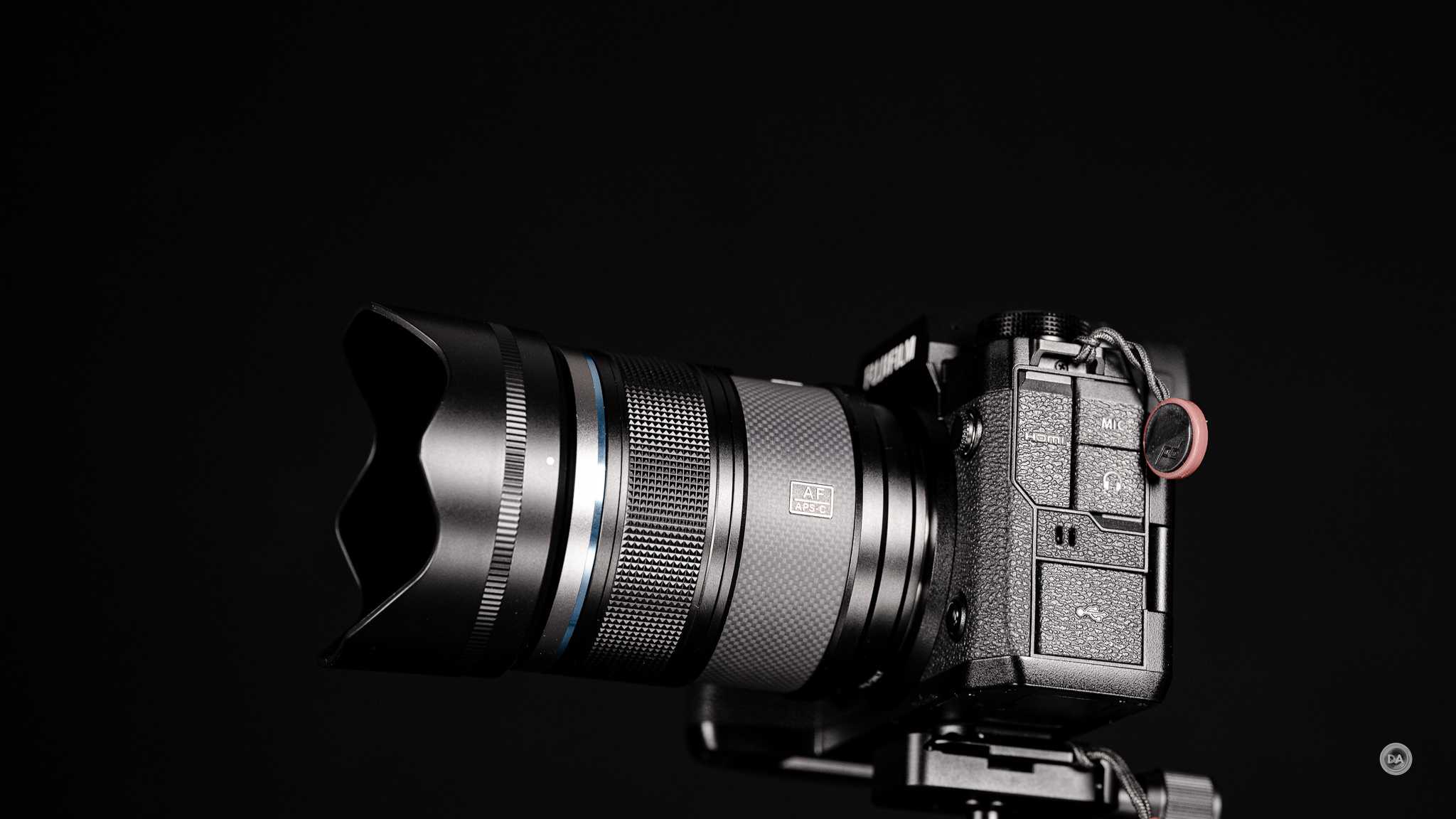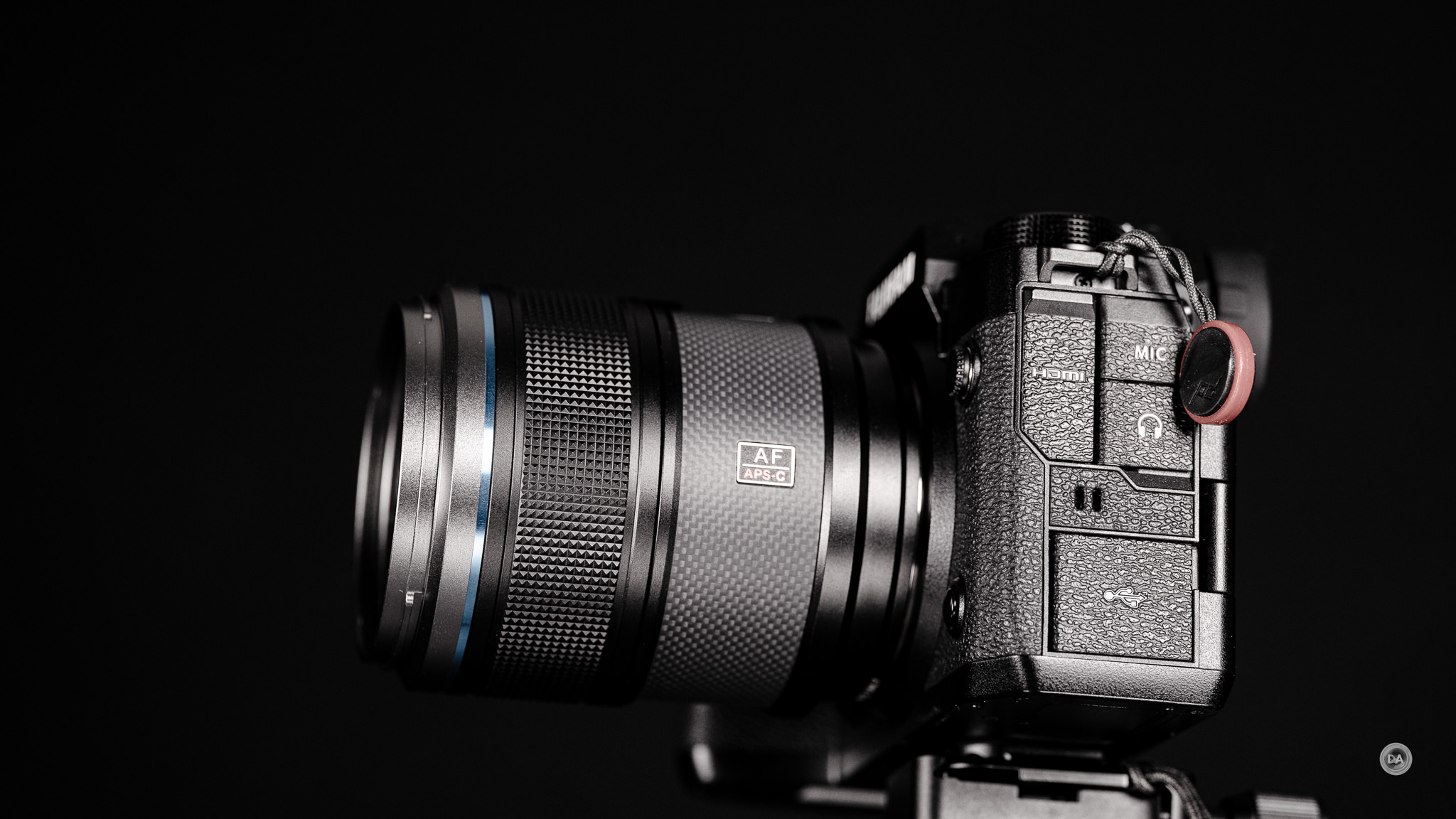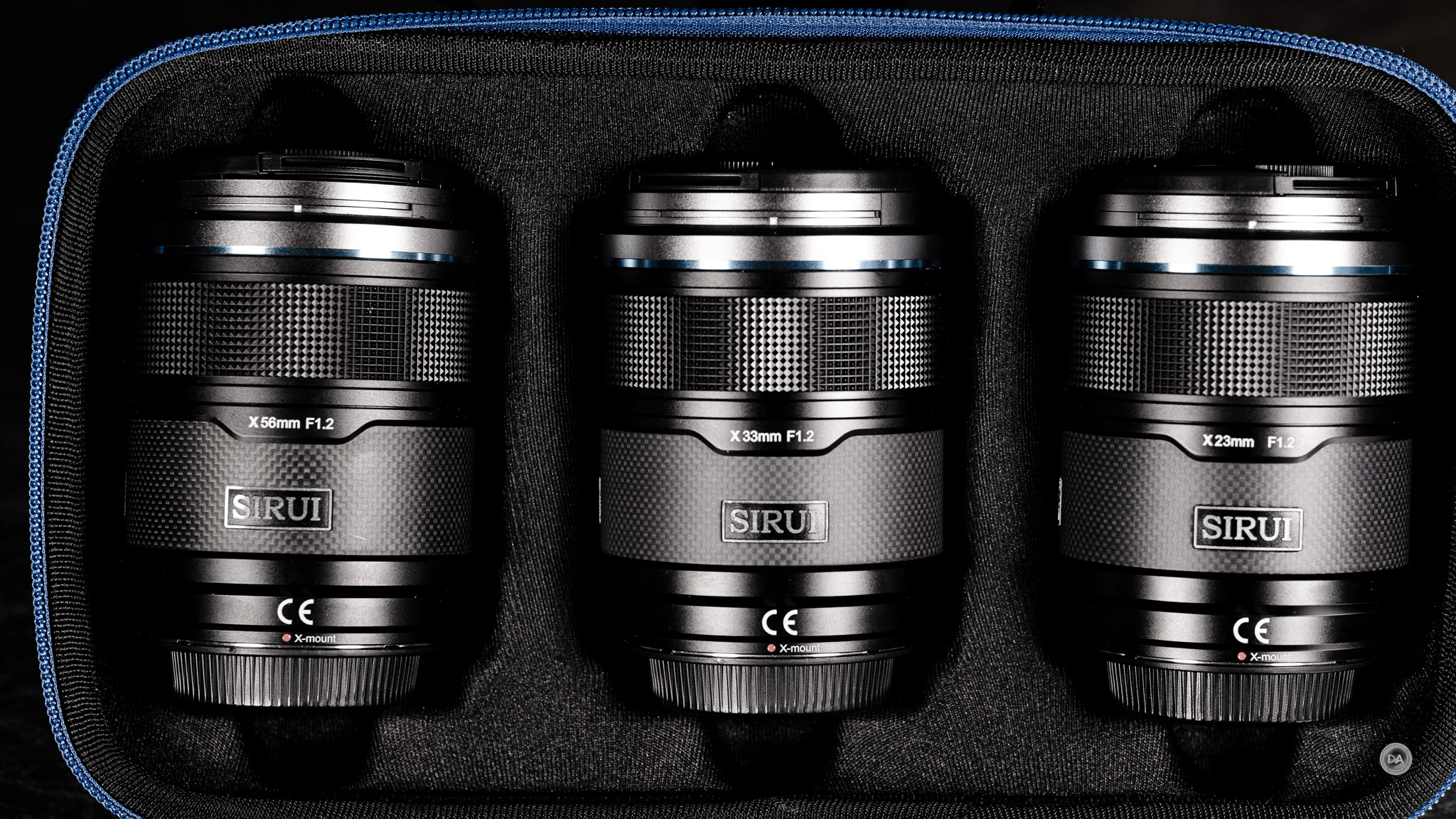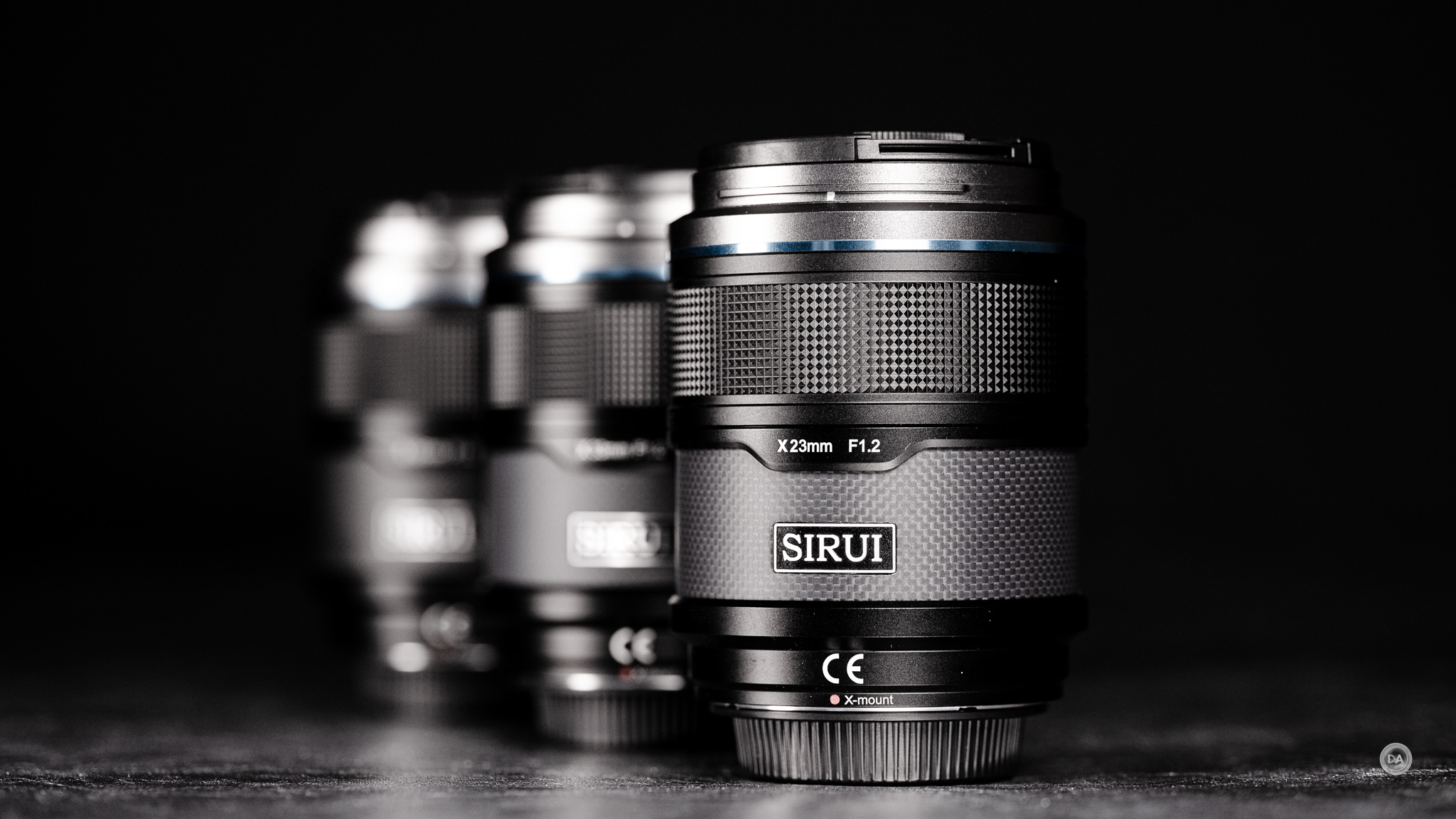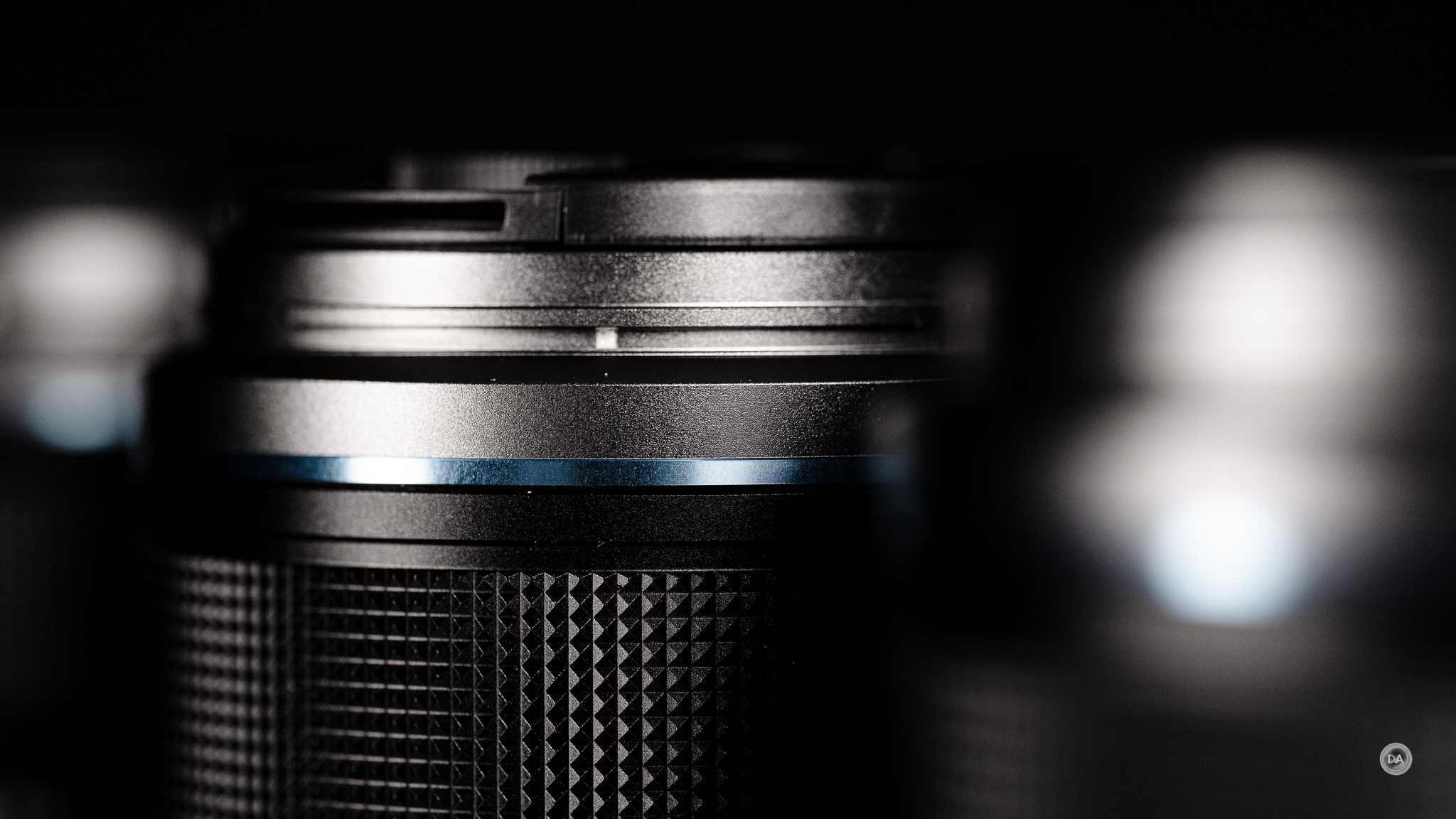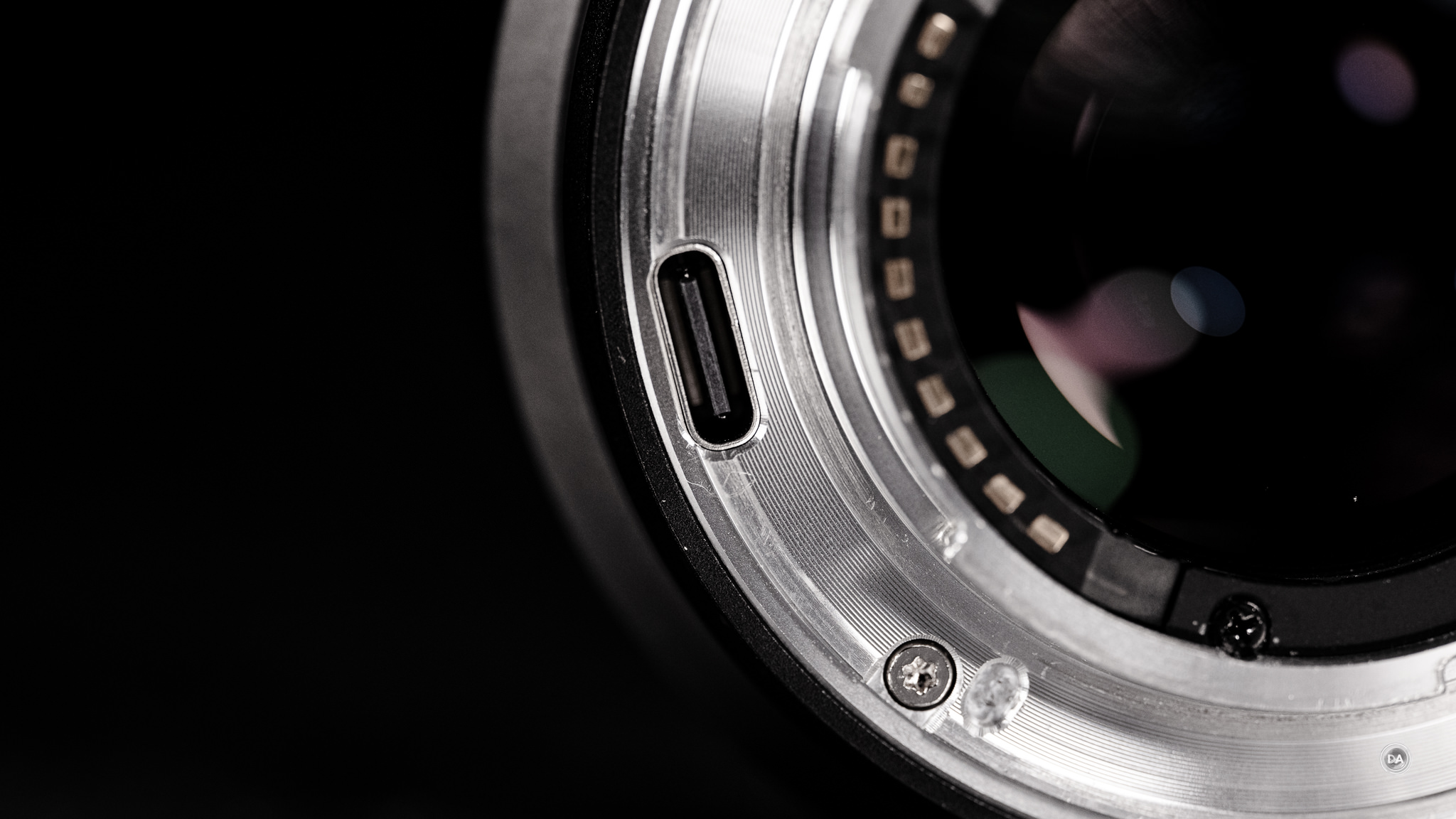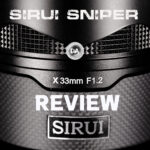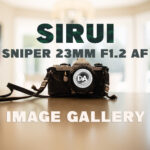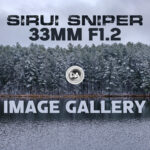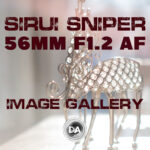
It is always interesting to see new lensmakers entering the market. Sirui started with cine (video) lenses (all manual – no autofocus or electronics), but they are now releasing their first autofocus lenses – called the “Sniper” series – and I’ve done an overview of the series here. The Sniper Series is (at least initially) made up of 3 APS-C specific lenses – a 23mm F1.2, 33mm F1.2, and 56mm F1.2 lens, with rumors . These can be purchased individually for $349 USD each (though in the first month a 15% discount will drop the price to $299 USD per lens) or as a set for $999 USD that comes in a custom designed case. These lenses will be available in Fuji X-mount (reviewed here), Sony E-mount, and Nikon Z mount configurations, though in all mounts they are designed to cover the APS-C and not the full frame image circle. Today’s review focuses on the Sirui Sniper 56mm F1.2 AF lens. Find out by watching my video review below…or just reading on.
Follow Me @ YouTube | Patreon | Instagram | Facebook | DA Merchandise | Flickr | 500px
Thanks to Sirui for sending me a set of review samples of the lenses. As always, this is a completely independent review. All opinions and conclusions are my own. I’m doing this review on a 40MP Fujifilm X-H2 camera.
__________________________________________________________________________________________________
I’m doing this review on Fuji X-mount today, as that is what Sirui had available to send me. In many ways this is jumping right into the fire, as there is no platform more optically demanding than the 40MP sensor on my Fujifilm X-H2. This is the equivalent of over 90MP on full frame, a resolution point that is currently 30+MP higher than what is even available on full frame. That creates an extremely demanding optical test that will push this new series to the limits. Is this 56mm F1.2 Sniper lens up to the challenge? As with the other lenses, that answer really depends on your priorities and expectations as a photographer. The 56mm (in particular) allows you to get images with an extremely shallow depth of field and with beautiful bokeh, but it has its own optical quirks and flaws.

56mm is obviously a popular focal length on APS-C (evidenced by the fact that there are a number of competitors at 56mm), as once you apply the 1.5x crop factor of the camera you mount it on (whether Fuji, Sony, or Nikon), you have a full frame equivalent focal length of roughly 85mm. That makes perhaps the most popular portrait focal length of all. The Sniper 56mm has an advantage over many competitors due to having a maximum aperture of F1.2, which is about a half stop faster/brighter than F1.4. In my quick illustrative test, my X-H2 metered at 1/90th second at F1.2, but 1/60th of a second at F1.4 with the Sniper 56mm F1.2 mounted. That’s an obvious advantage for the F1.2 in two ways: 1) when shooting in low light conditions that large aperture can suck in more light 2) the depth of field will shallower at F1.2 than F1.4, allowing for larger, softer bokeh highlights and a more blurred out background. That affords the opportunity to get very effective subject separation.

The Sniper series ambitiously will come in three different finish styles: a black/grey finish with carbon fiber accents (the lenses I’m testing come in this finish), a white finish, and a silver finish. Each is available for the three different mounts that lens is sold for.



We’ll explore the design more thoroughly in the next section, but I want to congratulate Sirui on forging their own design philosophy. These lenses don’t really look like anything else I’ve tested, but the design works and the lenses in person look quite premium. So, does bright F1.2 autofocusing lenses for a reasonable price sound interesting? We’ll explore that in this series of reviews. \
Here’s a quick way to access my reviews of each lens in the series:
Sirui Sniper 56mm Build and Handling
The Sniper series all share a common outer shell and exterior dimensions, though their weight varies due to the fact that the glass elements inside are larger and heavier in the 33mm and particularly the 56mm renditions. *This section will have a certain redundancy to my review of the series and other individual lenses because so much is shared in common, but I will give specifics in the few areas where the lenses vary from one another. The lenses share a common dimension of 72mm (by my measurement) or 2.83″, and in X-mount they are 92.2mm (3.6″) in length. They all share a common 58mm front filter thread, making it easy to share filters across the set. Here’s a look at the individual specifications of each lens.

As noted, the weight varies according to lens and mount. The X-mount that I’m testing is actually the lightest (by a few grams), due to the X-mount being the smallest of the three in diameter. Nikon’s Z-mount is the largest in diameter, with Sony E-mount in between. The 23mm weighs in at 380g (13.4oz), the 33mm at 398g (14oz), and the 56mm is 419g (14.7oz). That makes these lenses larger and heavier than similar 56mm lenses from Sigma (280g) or Viltrox (290g), though those lenses are F1.4 rather than F1.2. Sirui has taken a bit of a gamble here. Going to a bright F1.2 aperture allows their lenses to stand out from the competition, but those looking to travel small and light might shy away.
As noted, the look of the lenses is unique. There’s not much here in terms of features, but the lenses do have an upscale look with a variety of textures and finishes. I’m reviewing the lenses labeled as being “black”, but black (at least in the typical lens sense) is not the vibe I get off these lenses. There are two metal sections (one near the lens mount and another in the middle of the lens) that has a traditional anodized satin black finish, but in between there is a section of genuine carbon fiber that looks very cool. Carbon fiber is a more upscale material and it definitely sets these lenses apart.

There are two badges in this section. One is a plate with the Sirui banding in raised metal lettering.

The second is on the left side, and there is a another smaller badge that says AF and APS-C. Interestingly the word “Sniper” appears nowhere on the lens.
There are no switches on the lens barrel nor an aperture ring. That’s more noticeable here on Fuji, where aperture rings are fairly standard. The similarly priced Viltrox AF 23/33/56mm F1.4 lenses have aperture rings, and obviously Fuji’s own 23mm and 33mm F1.4 lenses along with the 56mm F1.2 lens have aperture rings, though, to be fair, those lenses cost nearly as much as the whole Sniper series, not one lens. Sigma’s DN prime lenses do not have aperture rings.
The closest competitor on X-mount will be the slightly less expensive Viltrox AF 56mm F1.4 ($292 USD), with the higher performing Sigma 56mm F1.4 coming in at $429 and Fuji’s own premium 56mm F1.2 WR being the top choice at $899 USD. The Viltrox and Sigma lenses are lighter while the Fuji lens is fairly comparable in weight.

That middle anodized metal section includes an interesting projection over the carbon fiber section that has the lens designation there, including the mount (X, on my review samples), focal length, and maximum aperture value. Keeping that section facing forward in the lens case is important as it allows you to easily distinguish which lens is which – important, since they all look the same.
Next comes a manual focus ring with a diamond pattern akin to Canon’s control rings rather than a typical ribbed finish. It’s one more area where the lenses maintain their own unique look.
The manual focus rings move smoothly and the weight is fairly light. Not so light that you can’t accurately focus, but a bit lighter than what I personally prefer. There is no obvious stepping when manually focusing, though I do find (as per usual on Fuji!) that large manual focus changes require a number of rotations. This is particularly true if you are trying to focus towards minimum focus; I counted 6 full rotations to get from 1 meter to minimum focus.
After the focus ring is a blue accent ring that is nearly turquoise in color. Once again it is little different than other lens that I’ve tested, and it works. The final section at the front of the lens has a titanium colored anodized metal finish, so less than half of the lens surface is actually purely black. Each lens color has some unique ingredient: black = carbon fiber, silver = aluminum alloy, white = ceramic baked paint.
A look at the front of the lens shows the 58mm filter threads (in metal), along with a front façade that has the lens designation and the filter size on the opposite side.

The included lens hoods are not quite as special. They are made of plastic and feel considerably cheaper than the lens itself, which feels quite premium. The hoods for the 23mm and 33mm are petal shaped while the hood for the 56mm is deeper and without the scallops. I do appreciate the ribbed section in the hood which gives a little more grip.

It’s worth noting that both the front pinch cap along with the rear cap are quite low profile. The front cap is just a few millimeters thick, and the rear cap too feels slimmer than usual. These little details stood out to me as nothing about the lenses felt generic or “by-the-numbers”. Sirui is doing their own thing here, and I like the attention to detail.
At the rear of the lens we have a metal lens mount complete with the appropriate electronic contacts; aperture will be controlled from the camera. There is a USB-C port there that will allow for future firmware updates. That’s a really important move by Sirui, as they are new to autofocus design. The ability to update the focus algorithms in their lenses will help them to focus better in the future and also allows the lenses to be futureproof.
The aperture iris is made up of a higher-than-average 11 rounded blades. That’s a great choice in a lens with an F1.2 aperture, as it helps assure that the aperture iris stays circular as the lens is stopped down. Here’s a look at the aperture stopped down to F16:

The minimum focus distances varies from lens to lens, with the 23mm focusing as closely as 30cm, the 33mm focusing as close as 40cm, and the 56mm jumping to 60cm. The magnification for each lens looks pretty similar, however. Sirui has not listed the maximum magnification, but it looks to be in the very low 0.10x range. Here’s a look at the 56mm’s maximum magnification.

The large maximum aperture will allow you to strongly blur out backgrounds if you get close, but some competing lenses will allow you to get closer and get a higher level of magnification. You can see from this shot of a lock that I can’t get particularly close to the subject, but the big aperture blurs out the background pretty well anyway.

There is no weather sealing gasket on the Sirui Sniper lenses or internal seals. These are not weather resistant lenses.
There are some pros and cons for the design and handling. On the positive side, the lenses look and feel great. There are some premium materials being used in the design and the attention to detail is excellent. On the negative side, there are no real features on the lenses outside of the USB-C port for firmware updates and the lenses are the largest and heaviest in the class. But also worth considering is that the lenses have a larger maximum aperture than competing lenses and also carry a bargain price tag for autofocusing F1.2 lenses.
Autofocus Performance
The Sirui Sniper lenses are all equipped with STM (stepping) focus motors. There is a certain amount of autofocus performance that is camera and camera system specific, so I’ll try to distinguish between the lens performance and the system performance as much as possible. My experience is that third party lenses focus better on Sony (I don’t test Nikon) than they do on Fuji, and that’s largely because Fuji’s autofocus systems in their cameras are not quite as sophisticated as equivalent Sony cameras.
Autofocus speed is a slightly below average for a modern STM motor. When doing my focus speed tests with the Sniper 56mm from close to distance, I found that I could see my subject coming into focus rather than just instantly being in focus. When I went outdoors, focus speed picked up, though it still isn’t the instant focus I see with the better modern lenses. There is light clicking sound that I noticed during my focus tests, and the cause is pretty obvious with my outdoor test. Whenever I ease off the shutter button (I typically hold it halfway for these tests so that the camera is focusing but not taking photos) the aperture closes down considerably, and opens up again whenever I depress the shutter button again. You can see a pretty radical difference between the degree of background blur when you go to focus if you have a large aperture selected. That clicking sound is the sound of the aperture blades snapped closed.


The shot of Nala above shows in the crop that the autofocus is in fact accurate on the iris, but the combination of a very shallow depth of field and rather low contrast doesn’t make focus “pop”.
When I moved around with Eye AF engaged, focus tracked accurately and the green box stayed locked on the “eye” of my winter statue.

When I did my outdoor hike with the lens, I found that I could grab accurate focus of my various subjects in the woods.

Here’s another example, this one at F1.8:

Like other lenses in the series, autofocus isn’t fast, but it does seem to be accurate for stills/photography.
Turning to the video side of things exposed more serious issues. My autofocus pulls test was pretty much abysmal. The lens often got stuck in just not pulling focus, and when I did coax it to move, focus pulls were very slow and often failed to get to fully focused. There were visible steps and starts along the way. The microphone also picked up some faint clicks and whirs during the focus action.
My hand test (where I alternately block and then unblock the camera’s view of my face with my hand) was also frustrating. The ability to accurately focus was better which is consistent with my experience with Fuji’s recent AF systems; they function best when there is a trackable subject that AI recognizes. The lens is not reactive, so there’s a bit of a pause before focus transitions start after the hand is added or removed, and often focus had just not arrived at the destination before it needed to start moving again…even though I was moving slower and more deliberately than usual. That being said, if you want a reactive autofocusing video lens, this isn’t it.
On a positive note, focus breathing is quite low for a a 56mm lens.

If you rarely shoot video, then this lens will probably work fine, but if regularly doing video is a part of your image gathering, you’ll probably need to consider another 56mm option like the Sigma F1.4 or Fuji 56mm F1.2 lenses.
Sirui Sniper 56mm Image Quality
The Sirui Sniper lenses (surprisingly!) all share a common optical design of 12 elements in 11 groups, though they vary in the special elements in that formula. The 23mm has six HR (high refractive index elements). The 33mm has 1 ED (Extra low dispersion) and 1 HR element, while the 56mm has 1 ED element and 4 HR elements. Sirui claims that all three lenses have a uniform color tone, which adds to their value if you are using them as a set. I tried to get an MTF chart of the lens, but Sirui was a little coy about sharing their MTFs.
Like the other lenses in the series, the Sniper 56mm has somewhat of a dual personality. At large apertures it epitomizes the idea of a “dreamy” rendering, which is the euphemistic way to describe a somewhat soft, low contrast lens (though not as soft as the 33mm). At smaller apertures contrast and detail increases and it becomes a more typical lens. This image, for example, is quite sharp at F5.6 and has good contrast.

I haven’t tested any of the competing 56mm lenses on 40MP as of yet, so I’ll reserve judgment, though I will say the extremely detailed performance of the Sigma 56mm F1.4 on Sony suggests that it will definitely be considerably sharper than this lens. I’ve heard similar things about Fuji’s new WR version of the 56mm F1.2 (which is on my short list of Fuji lenses to test in 2024). I can say that the Viltrox Pro AF 75mm F1.2 (a larger, somewhat more expensive lens at $549) is much sharper while also having very nice bokeh. At large apertures the Sniper 56mm is pretty the anti-Sigma; it isn’t particularly sharp but has lovely bokeh, while the Sigma was incredibly sharp but the quality of the bokeh didn’t particularly impress me. I prefer the Viltrox 75mm for the simple reason that is has both.
There’s more to lens performance than just pure sharpness, though, and this lens does have an advantage over the some alternatives in terms of the aperture. You have the opportunity to get a little bigger, softer bokeh out of the Sirui Sniper 56mm…but that bokeh is going to come at the cost of reduced contrast and some fringing.

Our optical deep dive starts with a look at vignette and distortion, an area where the Sniper lenses have held up quite well. The 56mm is no exception, showing only a bit of pincushion distortion and quite low vignette…particularly for an F1.2 lens. I used only a -4 to correct manually for the distortion, and a +37 for the vignette, which is just a bit more than one stop.

Interestingly, there seems to be a correction profile available in Lightroom already and it seems to do a perfectly capable job of clearing up what little vignette and distortion there is. This F1.2 image shows no vignette, and there isn’t enough distortion to be seen in real world images anyway.

That’s an area where the Sniper lenses have excelled, but our next test unearths a serious weak point for the series – longitudinal chromatic aberrations.

While not quite as bad as the 33mm, you will definitely see plenty of fringing before or after the plane of focus, including noticeable fringing around the specular highlights (bokeh balls):

The heavy fringing issues definitely play a part in reducing the contrast.
Lateral chromatic aberrations show up near the edge of the frame in transitions from dark to light areas. These is some LaCA visible if I turn off corrections, though they also correctly easily.

So how about resolution? The 40MP Fuji X-Trans sensor tends to make all but the very sharpest of lenses look a little soft under the microscope of my tests, so be warned, as this is NOT one of the sharpest of lenses. I examine results at a 200% magnification, and that’s a lot to ask of any lens. Here’s a look at the test chart:

And here is a look at F1.2 crops from the center, then mid-frame, and then extreme lower right corner:



These crops shows us two things. 1) Contrast is very low, producing an end result that looks like Vaseline has been smeared on the lens. 2) There is a reasonable amount of resolution there, but the low contrast masks that.
You may want to sit down for this, but here’s a look at how the Viltrox Pro AF 75mm F1.2 compares at F1.2:

Ouch. That’s a radical, radical difference. The corners aren’t quite as dramatic, but not tremendously different.
Real world results at a kinder 100% magnification aren’t radically better. The crop below shows that the image is still pretty low contrast.


If your priority is sharp results at F2 or larger, you may want to consider a different lens. That being said, I’ve learned over my career as a reviewer that not all photographers value the same things. Some people prefer the “Sigma approach” where the lens design is highly corrected for aberrations and shows high contrast and detail at wide apertures. Others prefer the “dual nature” approach that is a little more old school: the lens is “dreamy” at large apertures (lower contrast and detail) and gets sharp and higher contrast when stopped down to small apertures. The classic Zeiss Planar 50mm F1.4 and the Voigtlander Nokton 40mm F1.2 are great examples of this approach, and they are both lenses that people still love. The softer rendering can be very flattering for people shots as they don’t expose as many skin flaws.
There is no great leap ahead in contrast at F1.4, though there is a bigger improvement at F1.8.

As I’ve done with other lenses in the series, I took a few photos at different apertures and blended them. The bokeh at F1.2 is wonderfully creamy, and I took an F2 shot for the subject to give both more sharpness and depth of field. The end result is a great looking image; creamy bokeh, nice detail, and a great retro vibe…which suits the subject.

F2.8 looks a bit better, and by F4 I would start to call the center sharp. By F5.6 the mid-frame is starting to look sharp, though the corners still aren’t there.

That allows landscape images to look good. I’m satisfied by the detail and contrast I’m seeing in this image.

Corner sharpness peaks at F8 (looking quite good). After F8 diffraction will start to soften the image, though frankly it isn’t as pronounced here because the lens doesn’t have amazing contrast at larger apertures anyway.

Here’s one more landscape style image that shows the better contrast and detail at smaller apertures.

Where I feel like the lens shines is when it comes to bokeh rendering. It can really blur out a background, leaving a nice subject separation. The falloff from focus to defocus is handled nicely.

When you are closer, it’s easy to blur the background out even when shooting at an aperture like F2 (below).

Even when shooting in the transition zone (where a lot of the image is partway between focus and defocus), the results look pretty good.

Flare resistance is pretty much non-existent. If there are bright lights in the frame, this lens will do all the things. Flashes, veiling, ghosting, streaks…all of it. That can look really cool, like in this shot where multicolor light floods the image (at F1.2):

That looks great, to my eye.
This flash of light also looks pretty cool:

Most of what I liked, however, was at large apertures. At smaller apertures the streaks and rays become longer and potentially more destructive.

Here’s a variety of images depicting these various flare phenomena at a few different apertures and positions.






Your opinion on all of that will largely depend on what you’re looking for from the lens – corrections or character. If it is corrections of flaws you want, then look elsewhere, but if you want some character, then the Sniper 56mm might just be your “cup of tea”. This personality of this lens is definitely weighted more towards “vintage” than “modern”. It does give you a variety of different “looks” if you want that kind of versatility. Even the variety of flares could be used to artistic effect by a talented photographer.
This is not a “modern” perfectly corrected lens; it has aberrations and flaws, and you’ll either love it or hate it depending on your tastes as a photographer. You can check out the image gallery to see more photos and see if the rendering from the lens suits you.
Conclusion
The Sirui Sniper 56mm F1.2 AF lens is a throwback in so many despite its thoroughly modern appearance. It has a character more like some of my old M42 mount film era lenses that I like to pull out when I’m feeling particularly creative. This lens has none of the typical modern corrections, so there are aberrations, flares, and low contrast at larger apertures. Yet all of that may actually appeal to a certain audience.

I hear all the time from photographers who are tired of perfectly corrected modern lenses which they feel have no character. If you happen to be one of those people, then the Sirui Sniper series may really appeal to you. They are a little soft for my tastes, yet I definitely took images with the Sniper 56mm that I really liked. Perfection isn’t everything…

The Sirui Sniper 56mm F1.2 AF is definitely the kind of lens that is designed for the person who cares more about the look of images globally than they do of pixel peeping, and, if that describes you, then the Sniper 56mm offers a fair amount of value at its MSRP of $349 (you can save another 5% by using the code DustinA at Sirui). This is a short telephoto lens that can deliver artistic images that have some personality…or sharpen up nicely if you stop it down.

Pros:
- Unique design that uses premium materials
- Bright F1.2 aperture
- Ability to upgrade firmware through USB-C port
- Good focus accuracy for stills
- Focus motor reasonably quiet
- Low distortion and vignette
- Nice bokeh and rendering
- Good “look” and character to images
- Option to buy as a set
- Well priced
Cons:
- Larger and heavier than most competing lenses
- Low maximum magnification
- Video focus is pretty terrible
- Strong fringing
- Low contrast through F4
- Fairly soft at large apertures
- Very flare prone
__________________________________________________________________________________________________
GEAR USED:
Purchase the Sirui Sniper Lenses @ Sirui (use code DustinA for 5% off) | B&H Photo | Adorama | Amazon | Amazon Canada | Amazon UK | Amazon Germany
Purchase the Fujifilm X-H2 @ B&H Photo | Adorama | Amazon | Camera Canada | Amazon Canada | Amazon UK | Amazon Germany
Purchase the Fujifilm X-T5 @ B&H Photo | Amazon | Camera Canada | Amazon Canada | Amazon UK | Find it Used at KEH
Purchase the Fujifilm X-S20 @ B&H Photo | Adorama | Amazon | Camera Canada | Amazon Canada | Amazon UK | Amazon Germany | Ebay
Want to support this channel? Use these affiliate links to shop at: B&H Photo | Amazon | Adorama | Camera Canada | Amazon Canada | Amazon UK | Ebay | Make a donation via Paypal
Buy DA Merchandise https://bit.ly/TWIMerch

Keywords: Sirui, Sniper, Sirui Sniper, 23mm, 33mm 56mm, F1.2, STM, Carbon Fiber, Review, Fuji X, Sony E, Review, Telephoto, Action, Tracking, Hands On, Dustin Abbott, Real World, Comparison, Sharpness, Bokeh, Flare Resistance, Autofocus, Image Quality, Sample Images, Video, Photography, Sony a6700, Sony a6600, Fujifilm X-T5, Fujifilm X-H2, let the light in, #letthelightin, DA

